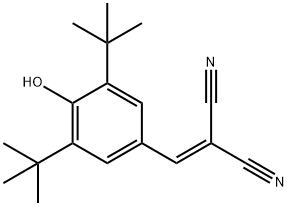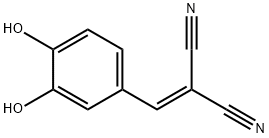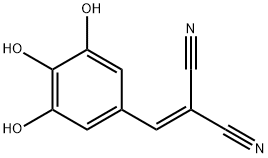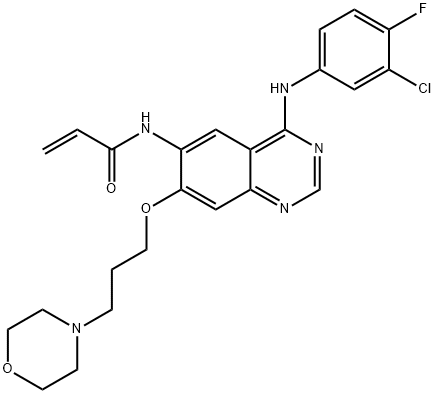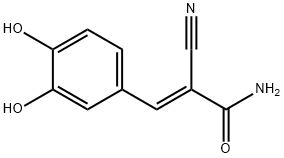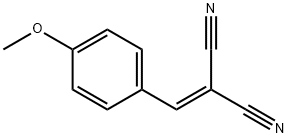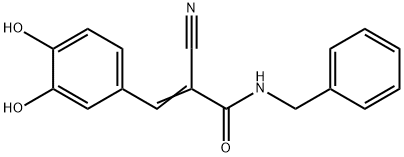AG 213
- CAS NO.:122520-86-9
- Empirical Formula: C10H8N2O2S
- Molecular Weight: 220.25
- MDL number: MFCD00133902
- SAFETY DATA SHEET (SDS)
- Update Date: 2023-05-18 11:31:21

What is AG 213?
Description
Protein tyrosine kinase (PTK) inhibitors are potential antiproliferative agents for diseases caused by the hyperactivity of PTKs. Tyrphostins are a class of antiproliferative compounds that act as PTK blockers. PTK inhibitors which preferentially inhibit the epidermal growth factor (EGF) receptor kinase block EGF-
The Uses of AG 213
Tyrphostin 47 is a potent inhibitor of EGFR kinase activity.
What are the applications of Application
Tyrphostin 47 is a potent inhibitor of EGFR kinase activity
Definition
ChEBI: 3-amino-2-[(3-hydroxy-4-oxo-1-cyclohexa-2,5-dienylidene)methyl]-3-mercapto-2-propenenitrile is a member of quinomethanes.
Biological Activity
Epidermal growth factor receptor (EGFR) and platelet-derived growth factor receptor (PDGFR) kinase inhibitor (IC 50 values are 2.4 and 3 μ M respectively). Stimulates microtubule polymerization and promotes neurite outgrowth > 17-fold over basal conditions in vitro . Also weakly inhibits protein kinase C (IC 50 = 60 μ M).
References
[1] romer l h, mclean n, turner c e, et al. tyrosine kinase activity, cytoskeletal organization, and motility in human vascular endothelial cells[j]. molecular biology of the cell, 1994, 5(3): 349-361.
[2] gazit a, yaish p, gilon c, et al. tyrphostins i: synthesis and biological activity of protein tyrosine kinase inhibitors[j]. journal of medicinal chemistry, 1989, 32(10): 2344-2352.
[3] levitzki a, gazit a. tyrosine kinase inhibition: an approach to drug development[j]. science, 1995, 267(5205): 1782.
[4] herbst r s. review of epidermal growth factor receptor biology[j]. international journal of radiation oncology biology physics, 2004, 59(2): s21-s26.
Properties of AG 213
| Melting point: | 213 °C |
| Boiling point: | 474.5±55.0 °C(Predicted) |
| Density | 1.512±0.06 g/cm3(Predicted) |
| storage temp. | 2-8°C |
| solubility | DMSO: 50 mg/mL, clear, orange |
| form | Orange solid. |
| pka | 8.82±0.10(Predicted) |
Safety information for AG 213
| Signal word | Warning |
| Pictogram(s) |
 Exclamation Mark Irritant GHS07 |
| GHS Hazard Statements |
H302:Acute toxicity,oral H315:Skin corrosion/irritation H319:Serious eye damage/eye irritation H335:Specific target organ toxicity, single exposure;Respiratory tract irritation |
| Precautionary Statement Codes |
P261:Avoid breathing dust/fume/gas/mist/vapours/spray. P304+P340:IF INHALED: Remove victim to fresh air and Keep at rest in a position comfortable for breathing. P305+P351+P338:IF IN EYES: Rinse cautiously with water for several minutes. Remove contact lenses, if present and easy to do. Continuerinsing. P405:Store locked up. |
Computed Descriptors for AG 213
New Products
Indole Methyl Resin tert-butyl 9-methoxy-3-azaspiro[5.5]undecane-3-carboxylate Boc-His(Boc)-OH 2-CTC Resin 4-Chloro-7-tosy1-7Hpyrrolo[2,3-d]pyrimidine 5,7-Dibromo-1H-indole 2,5-dichloro-N-hydroxy-4,6-dimethylpyridine-3-carboximidamide 2,2-Dimethoxy-7-azaspiro[3.5]nonane hydrochloride 4-chloromethyl-5-methyl-1,3-dioxol-2-one (DMDO-Cl) R-2-BENZYLOXY PROPIONIC ACID 1,1’-CARBONYLDIIMIDAZOLE 1,1’-CARBONYLDI (1,2-4 TRIAZOLE) N-METHYL INDAZOLE-3-CARBOXYLIC ACID 4-((2-hydroxyethyl)thio)benzoic acid 1-(TERT-BUTOXYCARBONYL)-2-PYRROLIDINONE Methyl 6-methylnicotinate 3-Pyridineacrylic acid tert-Butyl carbazate TETRAHYDRO-2H-PYRAN-3-OL 2-((4-morpholinophenylamino) (methylthio) methylene) malononitrile 3-(4-morpholinophenylamino)-5-amino-1H-pyrazole-4-carbonitrile 2,4-dihydroxybenzaldehyde 1,3-Diethyl-1,3-Diphenylurea Methyl 2-methylquinoline-6-carboxylateRelated products of tetrahydrofuran
You may like
-
 Pyridine 99.5% HPLC /UV SpectroscopyView Details
Pyridine 99.5% HPLC /UV SpectroscopyView Details
110-86-1 -
 Guanine , 99%View Details
Guanine , 99%View Details
73-40-5 -
 Piperazine Spot supply, best priceView Details
Piperazine Spot supply, best priceView Details
110-85-0 -
 Potassium Hydroxide 90%View Details
Potassium Hydroxide 90%View Details
1310-58-3 -
 Dibutyl PhthalateView Details
Dibutyl PhthalateView Details
84-74-2 -
 Imidazole Spot supply, competitive priceView Details
Imidazole Spot supply, competitive priceView Details
288-32-4 -
 Octadecyl 3-(3,5-di-tert-butyl-4-hydroxyphenyl)propionate 98% (GC)View Details
Octadecyl 3-(3,5-di-tert-butyl-4-hydroxyphenyl)propionate 98% (GC)View Details
2082-79-3 -
 Thiourea 99% ARView Details
Thiourea 99% ARView Details
62-56-6

